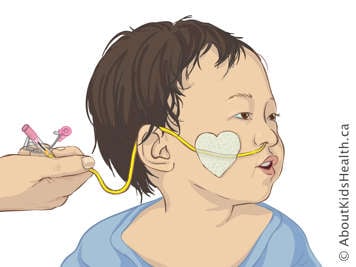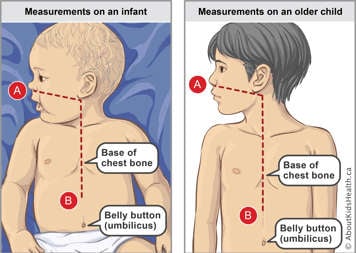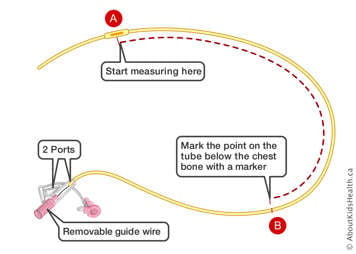
What is a nasogastric tube?
A nasogastric (NG) tube is a long, thin, hollow tube which is passed through a nostril of the nose into the throat and down into the stomach. You can use the tube to feed your child if they are unable to take enough food by mouth or they are not safely able to take food by mouth. Liquid nutrition (feeds) passes through the tube into the stomach.
How do you insert the tube?
Preparing the tube for insertion
- Gather the following equipment and have it within close reach:
- Silastic NG tube with guidewire, size _____
- Cut pieces of a non-allergenic tape, such as Hypafix
- Straw in a glass of water (for drinking) for a child or a soother for an infant (optional)
- Water (to flush the tube)
- Water-soluble lubricant
- Permanent writing marker
- 2 syringes
- pH test strips
- Wash your hands.
- Measure the NG tube.
- For babies, lay your baby face up in a neutral position. Older children may sit.
- Hold the end of the tube with the exit hole at your child’s nostril.
- Measure the tube from the nostril to the base of the ear lobe. Continue measuring from the base of the earlobe to about halfway between the base of the chest bone and the umbilicus, or "belly button".

- Using a permanent marker, mark the halfway point between the base of the chest bone and the belly button. Let the ink dry.

- If the NG tube has a guidewire, check that the guidewire is easy to remove by pulling it out a few centimeters, then put it back in and screw it on the main port of the tube.
Inserting the tube
When inserting or changing the tube, try to alternate nostrils. A soft silastic NG tube can remain in place for one month. Remember to change it every month.
Every time you insert an NG tube, you must follow the following steps:
- If your child is a baby or very young, lay them down and bundle them in a blanket to help hold their arms and legs. Older children may sit back in a chair or bed with back support, with their head and neck in a neutral position or slightly raised.
- Dip the tip of the tube in water or water-soluble lubricant (e.g., K-Y Jelly or Muko). This will make it easier to insert the tube. Do not use petroleum jelly (e.g., Vaseline) for lubrication.
- Insert the end of the tube into the nostril you have chosen and advance the tube slightly down and towards the ear on that side. Do not force the tube.
- You can give your infant a soother to help them swallow during tube insertion. For older children, if they can have water, they may sip water through a straw during tube insertion. If they are not allowed to drink, tell them to swallow as the tube goes down.
- Continue to advance the tube until the marked spot reaches the nostril.
- If the tube comes back out of your child’s mouth, remove the tube and let your child recover. Then, start again.
- Be alert for accidental placement of the NG tube in the airway (windpipe). If the tube is in the airway, your child may choke, cough or have trouble breathing or speaking. If this happens, REMOVE THE NG TUBE IMMEDIATELY. Let your child rest and start again once they feel better.
- Secure the tube to your child’s face with tape. Avoid kinking the tube.
- Attach an empty syringe to the NG tube’s side port and obtain a sample of stomach contents. Test the pH of the fluid using a pH strip.
- The pH should be 5.5 or below. For more instructions on checking pH and troubleshooting, see the following section.
- If your child’s tube has an internal lubricant, activate the internal lubricant by flushing the tube with up to 10 mL of water through the side port. You can flush with 2 mL of water for small tubes.
- Unscrew the guidewire and remove it slowly. Do not throw away the guidewire.
- Resecure the tape to your child’s face, ensuring the tape does not cover their nostril.
Check the placement of the tube
Check your child’s tube placement:
- Before using the tube for feeds, fluids or medications
- When a new tube is put in
- When you are concerned that the tube may have come out or moved
- If your child is choking, vomiting, coughing or having trouble breathing or speaking
Check the tube placement using the following method:

- Attach the empty syringe to the tube and gently flush with air to clear the tube. Then pull back on the plunger to withdraw about 2 mL of stomach contents.

- Wet the pH testing paper with the stomach contents and compare the color with the label on the container. The pH should be 5.5 or below. You can also ask your child’s health-care provider what pH to expect.
- The pH may be above 5.5 if your child is on stomach acid suppressing medications or has recently been fed. If this is the case, check if the stomach contents looks like your child’s usual stomach contents. If it does not or you are unsure, do not use the tube. Remove and reinsert the NG tube, then confirm placement with pH or contact a member of your child’s health-care team.
- If the pH is above 5.5 and your child does not take stomach acid suppressing medications or has not recently been fed, then the tube may not be in the stomach. Do not use the NG tube. Remove and reinsert the NG tube, then confirm placement with pH or contact a member of your child’s health-care team.
- If you have trouble pulling back some stomach contents to do the pH test, try the following:
- Use a larger syringe and draw back more gently to prevent collapsing the tube.
- Push in 1 to 2 mL of air through the NG tube into the stomach and gently draw back on the syringe.
- Change your child’s position by having them lie on their left side for a few minutes to move the position of the tube in the stomach.
- If you are still unable to obtain stomach contents to test pH, consider removing the tube and reinserting it, then checking for stomach contents or contact a member of your child’s health-care team.
For more information, please see Nasogastric (NG) tube: Feeding your child and Nasogastric (NG) tube feeding: Common problems
